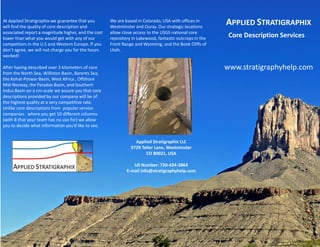brochure
- 1. APPLIED STRATIGRAPHIX Core Description Services www.stratigraphyhelp.com At Applied Stratigraphix we guarantee that you will find the quality of core description and associated report a magnitude higher, and the cost lower than what you would get with any of our competitors in the U.S and Western Europe. If you don’t agree, we will not charge you for the hours worked! After having described over 3 kilometers of core from the North Sea, Williston Basin, Barents Sea, the Kohat-Potwar Basin, West Africa , Offshore Mid-Norway, the Paradox Basin, and Southern Indus Basin on a cm-scale we assure you that core descriptions provided by our company will be of the highest quality at a very competitive rate. Unlike core descriptions from popular service companies where you get 10 different columns (with 8 that your team has no use for) we allow you to decide what information you’d like to see. We are based in Colorado, USA with offices in Westminster and Ouray. Our strategic locations allow close access to the USGS national core repository in Lakewood, fantastic outcrops in the Front Range and Wyoming, and the Book Cliffs of Utah. Applied Stratigraphix LLC 9729 Teller Lane, Westminster CO 80021, USA US Number: 720-434-3864 E-mail info@stratigraphyhelp.com
- 2. Bioturbated? Fractured? Mixed lithologies? Not a problem! Dr. Jaffri’s dissertation focused on Mixed Carbonate-Siliciclastic-Evaporite systems, therefore unlike most sedimentologists that either work with clastics or carbonates, we can work with both end members or any hybrid with equal ease. Sedimentology Our core log will include grain size, bedforms and sedimentary structures. Besides a graphic representation you will receive a description, process interpretation and environment of deposition report. Sequence Stratigraphy (Cycles) We can mark sequence boundaries and maximum flooding surfaces directly on the core log and add a column for systems tracts and fining-coarsening trends (cycles). Ichnology (trace fossils) and Bioturbation Index Bioturbation index shows the intensity of sediment churning and the preservation of original sedimentary fabric. Bioturbation can both enhance and degrade reservoir quality and we recommend a column that shows the Bioturbation Index such that you can determine the effect of bioturbation on the porosity and permeability of your reservoirs. Fractures We can document fracture type (extension vs shear), aperture size, mineral fill, porosity within fractures, density, intensity, orientation and determine the stress field in you area of interest. After having described fractures we can provide a diagnosis whether fractures might influence production from your wells. If this is the case, we then recommend a detailed fracture study. Since our specialization is restricted to sedimentology and stratigraphy we recommend you contact the experts at www.fracturestudies.com For fluvial strata we can use your core to calculate channel width, channel belt width and sinuosity such that you can take these parameters and plug them directly into Petrel or a geomodeling software of your choice. Electrofacies We can tie core facies with Gamma Ray or bore hole image logs to create electrofacies. We understand that its highly likely that the number of cored wells in your field is miniscule as compared to the total number of wells. Electrofacies allow you to correlate with greater confidence and are an excellent step towards creating facies logs in geomodeling software. For carbonates we always integrate core observations with microfacies analysis using thin- sections. This allows us to not only provide details on environments of deposition but porosity types and their relationship with permeability.

